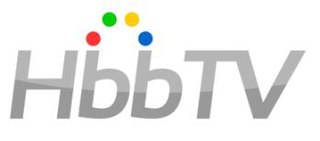Related Research Articles

Digital Video Broadcasting (DVB) is a set of international open standards for digital television. DVB standards are maintained by the DVB Project, an international industry consortium, and are published by a Joint Technical Committee (JTC) of the European Telecommunications Standards Institute (ETSI), European Committee for Electrotechnical Standardization (CENELEC) and European Broadcasting Union (EBU).

Video on demand (VOD) is a media distribution system that allows users to access videos without a traditional video playback device and the constraints of a typical static broadcasting schedule. In the 20th century, broadcasting in the form of over-the-air programming was the most common form of media distribution. As Internet and IPTV technologies continued to develop in the 1990s, consumers began to gravitate towards non-traditional modes of content consumption, which culminated in the arrival of VOD on televisions and personal computers.
MHEG-5, or ISO/IEC 13522-5, is part of a set of international standards relating to the presentation of multimedia information, standardised by the Multimedia and Hypermedia Experts Group (MHEG). It is most commonly used as a language to describe interactive television services.
Integrated Services Digital Broadcasting is a Japanese broadcasting standard for digital television (DTV) and digital radio.
Multimedia Home Platform (DVB-MHP) is an open middleware system standard designed by the DVB project for interactive digital television. The MHP enables the reception and execution of interactive, Java-based applications on a TV-set. Interactive TV applications can be delivered over the broadcast channel, together with audio and video streams. These applications can be for example information services, games, interactive voting, e-mail, SMS or shopping. MHP applications can use an additional return channel that has to support IP.

Interactive television is a form of media convergence, adding data services to traditional television technology. It has included on-demand delivery of content, online shopping, and viewer polls. Interactive TV is an example of how new information technology can be integrated vertically into established technologies and commercial structures.

Internet Protocol television (IPTV) is the delivery of television content over Internet Protocol (IP) networks. This is in contrast to delivery through traditional terrestrial, satellite, and cable television formats. Unlike downloaded media, IPTV offers the ability to stream the source media continuously. As a result, a client media player can begin playing the content almost immediately. This is known as streaming media.
Datacasting is the broadcasting of data over a wide area via radio waves. It most often refers to supplemental information sent by television stations along with digital terrestrial television (DTT), but may also be applied to digital signals on analog TV or radio. It generally does not apply to data which is inherent to the medium, such as PSIP data which defines virtual channels for DTT or direct broadcast satellite systems; or to things like cable modem or satellite modem, which use a completely separate channel for data.
TV-Anytime is a set of specifications for the controlled delivery of multimedia content to a user's local storage. It seeks to exploit the evolution in convenient, high capacity storage of digital information to provide consumers with a highly personalized TV experience. Users will have access to content from a wide variety of sources, tailored to their needs and personal preferences. TV-Anytime specifications are specified by the TV-Anytime Forum.
The Technology and Engineering Emmy Awards, or Technology and Engineering Emmys, are one of two sets of Emmy Awards that are presented for outstanding achievement in engineering development in the television industry. The Technology and Engineering Emmy Awards are presented by the National Academy of Television Arts and Sciences (NATAS), while the separate Primetime Engineering Emmy Awards are given by its sister organization the Academy of Television Arts & Sciences (ATAS).
In television technology, Active Format Description (AFD) is a standard set of codes that can be sent in the MPEG video stream or in the baseband SDI video signal that carries information about their aspect ratio and other active picture characteristics. It has been used by television broadcasters to enable both 4:3 and 16:9 television sets to optimally present pictures transmitted in either format. It has also been used by broadcasters to dynamically control how down-conversion equipment formats widescreen 16:9 pictures for 4:3 displays.
DVB Content Protection & Copy Management often abbreviated to DVB-CPCM or CPCM is a digital rights management standard being developed by the DVB Project. Its main application is interoperable rights management of European digital television, though other countries may also adopt the standard.
WTVML is an XML-based and WML-derived content format designed to allow web site operators to easily develop and deploy Interactive TV services, typically it reduces the time taken for web site operators to create a TV Site, and results in the Site being deployable on a larger number of devices, and is capable of being automatically validated, tested and transformed.

A free-to-air or FTA Receiver is a satellite television receiver designed to receive unencrypted broadcasts. Modern decoders are typically compliant with the MPEG-2/DVB-S and more recently the MPEG-4/DVB-S2 standard for digital television, while older FTA receivers relied on analog satellite transmissions which have declined rapidly in recent years.
Interactive television standards are standards for television broadcasting that relate to different modes of interaction and feedback mechanisms. This interaction system is what creates the television experience.
The DTG is the association for British digital television broadcasters and annually publish and maintain the technical specifications for digital terrestrial television (DTT) in the United Kingdom, which is known as the D-Book and is used by Freeview, Freeview HD, FreeSat and YouView. The association consists of over 120 UK and international members who can participate in DTG activities to varying degrees, depending on their category of membership.
Marlin is a DRM platform, created by an open-standards community initiative called the Marlin Developer Community (MDC). The MDC develops the necessary technology, partners, and services for enabling the creation of interoperable digital content distribution services.

Hybrid Broadcast Broadband TV (HbbTV) is both an industry standard and promotional initiative for hybrid digital TV to harmonise the broadcast, Internet Protocol Television (IPTV), and broadband delivery of entertainment to the end consumer through connected TVs and set-top boxes. The HbbTV Association, comprising digital broadcasting and Internet industry companies, has established a standard for the delivery of broadcast TV and broadband TV to the home, through a single user interface, creating an open platform as an alternative to proprietary technologies. Products and services using the HbbTV standard can operate over different broadcasting technologies, such as satellite, cable, or terrestrial networks.
DVB-RCT, provides a method by which the DVB-T platform can become a bi-directional, asymmetric, data path using wireless between broadcasters and customers. DVB-T when completed with DVB-RCT can be used not only for Interactive TV, but also for light IP telecommunication services. Various degrees of interactivity could be offered, without implying any return channel back from the user to the service provider: data carrousel or Electronic Programs Guides (EPG) are examples of such enhanced TV services which make use of “Local Interactivity”, without any return path from customer to provider. To implement new interactive services having a closely coupled and real-time relationship with the TV programs, a low latency return channel technology is mandatory, and this is the goal of the DVB-RCT. Without adding a cellular style network with about x20 more masts no Internet usage except about 1/20th speed of analogue dialup would be feasible.
References
- ↑ "Portable Content Format- a standard for describing an interactive digital television service". BBC R&D. Retrieved 2022-05-20.
- ↑ Rodriguez, Aitor; Moreno, Marc; Cespedes-Borras, Eduard; Carrabina, Jordi (October 2009). "Platform-independent web-based iTV services through DVB-PCF transcoding". 2009 2nd IEEE International Conference on Broadband Network Multimedia Technology: 504–508. doi:10.1109/ICBNMT.2009.5348538. ISBN 978-1-4244-4590-5. S2CID 9042042.